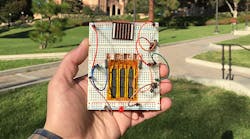Advances in mobiles and myriad other applications continue unabated, but battery development can’t seem to keep pace technologically. However, by combining the best qualities of batteries and supercapacitors, researchers at UCLA’s California NanoSystems Institute (with support from Nanotech Energy) created a new energy-storage medium that can last for more than 10,000 recharge cycles. Moreover, the combination of nanomaterials is able to store large amounts of energy and recharge quickly.
The microsupercapacitor merges laser-scribed graphene (LSG), a highly conductive material, with manganese dioxide, which is currently used in alkaline batteries to hold a charge. Extreme temperatures aren’t needed to fabricate the hybrid, and it doesn’t require the expensive dry rooms typically found in supercapacitor production. It’s so small—one-fifth the thickness of a sheet of paper—that it could be used in wearable or implantable devices. According to the research team, the supercapacitor has approximately six times the capacity of comparable supercaps.
The research team, led by Professor Richard Kaner and postdoctoral scholar, Maher El-Kady, found that the new supercapacitor could quickly store an electrical charge generated by a solar cell during the day, hold the charge until evening, and power an LED overnight. It’s suited for applications such as off-grid street lighting, and has shown potential for improving personal electronics technology.
